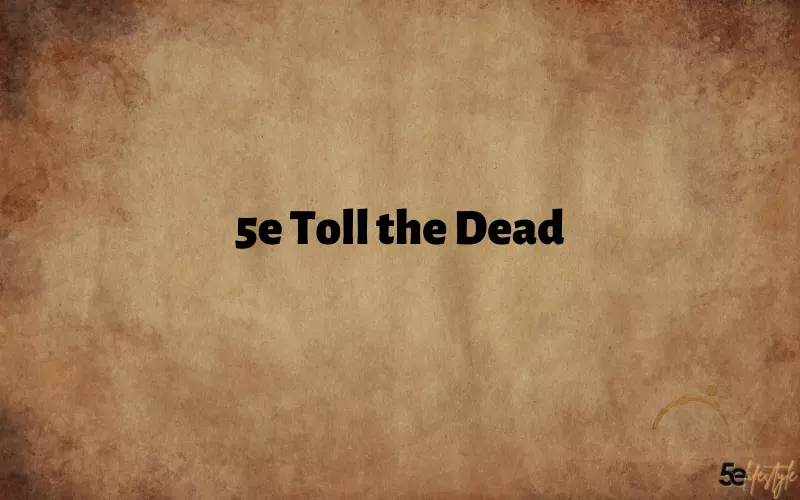Table of Contents
DnD 5e Toll the Dead
The Players Handbook offers a wide assortment of canopies, with each class essentially not overcrowded, which is the magic of going for a passenger. However, in some cases, it is possible to look at these run-downs in the past to use the extension of the rules, the crusade settings, and the opportunity to use the partnership as the second number.
For this article, we’ll take a deeper leap into a similar partnership with Xanathar’s Manual for Everything, Cantrip 5e Toll the Dead. Who projects it, how it respond, and – in particular – is it valuable as a primary concern when you’re submitting you’re run down?
What is 5eToll The Dead?
A brand-new spell for D&D 5E Toll the Dead does not appear in any of the earlier versions, however, it is safe to say that the third version of Mark of the End has another world ancestor. Despite the fact that the effects of magic are quite unique.
Spelling details are as follows:
School: Magic Cantrip
Projecting time: 1 activity
Range: 60 feet
Parts: V,
Classes: Pastor, Warlock, Wizard, Ministerial
The caster chooses an animal that he can see up close. At this point, when the spell is estimated, a melanoma ringer uses the space, and the target must save the insight or cause 1d8 necrotic damage. In the event that the target is effectively damaged by another means – overall, in the event that they are not in full HP – they take 1d12 necrotic damage considering all things. Adding d8 / d12 to the fifth, eleventh, and seventeenth levels makes this loss scale with the level.
It is an extension of the Cantrip Minister, Fighter, and Wizard records, giving it access to a wide range of classes. Also, of course, poets can reach it through the mysterious privileged Insight Class Highlight.
Since it is a runaway attack with necrotic damage, it can draw a connection with comparable fourth-degree magic, 5E’s Scourge, albeit with significantly less damage (5e Toll The Dead Insight save Will be more positive for the caster than the curse’s constitution save). In addition, Cost the Dead can damage a large number of rounds, without using spell space.
Apply for dead ambiguity.
Sometimes the real thing in spelling is not what the picture says, but what it doesn’t. How obscure parts are perceived often has a big impact on how the spell can be applied, and the way it works very well can be in the right circumstances.
For example, when the mantra says that “the sound of a tragic bell eats away at space”, it is not clear whether this is an imaginary effect that sees only the object or a real sound that everyone can hear. An Inquiry with Large Effects for Hidden Pin. Also, volume is a topic – what does it mean to “go around” in crude decibels? Furthermore, whether the target has the option to listen to the ringer, or to listen with any kind of imagination, is not specified – however since spells like Horrible Joke really determine it, So the most likely translation is don’t do it
While this may seem like advocacy of precise standards, such translations can completely change the magic and can affect when and how it is best used. The DM will continue to be the last word on such queries, so in the event that you have a mystical stunt shot as a primary concern, it is best to decide ahead of time, given the specific translation of the spell.
In fact, how does 5e Toll the Dead stack up?
So how does 5e Toll the Dead actually contradict the basic run-down of Cantrips for each class? We need to explore one of the most exciting choices one by one to see where Cost the Dead stands.
Clergyman
The pastors have only one canopy on their base run-down that allows them to deal with the damage – the sacred fire. Overall, does Cost the Dead make a seriously attractive alternative? How do we consider the amount of sacred fire vs. cast the dead?
The spheres of the two mantras are somewhat similar – 60 feet. The two mantras focus on an “animal you can see”, which removes the opportunity to target unrecognizable or generally hidden enemies.
The basic damage to both spells is 1d8, however, Cost the Dead finds an edge here for managing 1d12, assuming the goal has already done damage. The key qualifications here are – excellent damage to the sacred fire, and necrotic to the cast of the dead.
check out the rest of the site for more informative articles on a variety of topics! 5elifestyle



